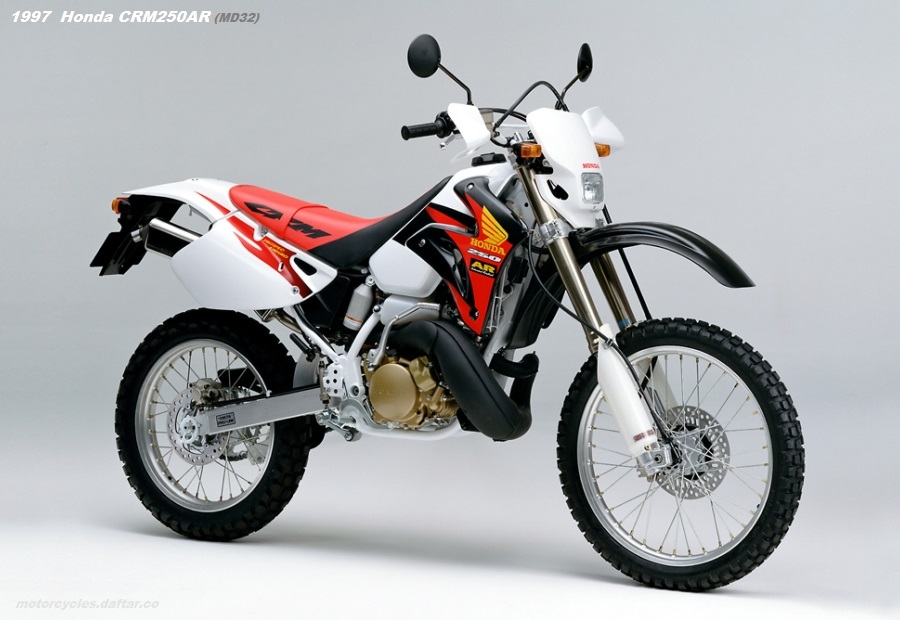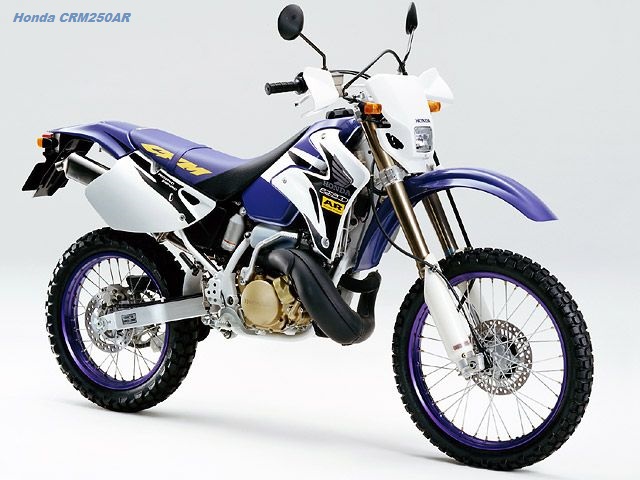Info About 1997 Honda CRM250AR (MD32) Overview, Specs, Pictures Gallery
Honda CRM250AR is a full-fledged dirt bike equipped with an epoch-making AR combustion engine with significantly improved fuel efficiency and enhanced output characteristics.
 |
| 1997 Honda CRM250AR photo. Release date: 1997-01-24 |
Honda Motor Co., Ltd. has developed a revolutionary AR (Activated Radical)* Combustion System” that aims to greatly improve the fuel efficiency of 2-cycle engines, propose HC in exhaust gas, and improve output characteristics. ‘Honda CRM250AR’, a land sports bike with a slim body and a powerful and light ride that can be used in a wide range of applications, from rough terrain to touring in the suburbs. The Honda CRM250AR, which appeared in January 1997, was a developmental model change of the CRM250R. It was the last 250cc2 stroke off-road trail for Honda. The CRM 250AR can be regarded as the final model of the CRM250R that has continued since 1989, but it is also due to the breakthrough that adopted a system that reduces the environmental load of the two-stroke engine called “AR combustion”, which was also used in the car name. , Bike Bros set both as different models. The water-cooled 2-stroke single-cylinder engine has a piston bore 0.4mm larger than its predecessor, the CRM250R, to increase the engine displacement to 249cc (previously 246cc), which is full of light motorcycle standards, and introduces an AR combustion system. AR is an acronym for Activated Radical, and in a very simple way, by using the free radicals in the residual gas remaining in the cylinder after combustion, The self-ignition of the introduced new air-fuel mixture. In the development of conventional 2-stroke engines, it was said that the self-ignition phenomenon should be prevented, but by using it in reverse, the combustion efficiency is improved, the hydrocarbons (HC) contained in the exhaust gas are reduced, and the fuel efficiency is improved. It was meant to improve. As a result, the CRM250AR, which adopted AR combustion, had halved the concentration of HC compared to the conventional model, and greatly improved fuel efficiency. Regarding the chassis structure as an off-road bike, the rigidity of the frame was increased and the stroke of the rear suspension was increased to improve running performance, and the amount of light from the headlights was also increased. The CRM250AR, which appeared with a revolutionary AR combustion engine, received a color change in December of the year of its introduction, and it became the final specification as it was.
The AR Combustion Engine installed in the Honda CRM250AR was developed as a technology that addresses energy conservation and environmental issues in 2-cycle engines, and overcomes irregular combustion in the low-load range where the accelerator opening is small, which can be said to be the normal range. This has improved fuel efficiency by 32% (compared with our products, 60km/h level driving test value) and realized output characteristics that are smooth and excellent in response, further enhancing the overall performance of the 2-cycle engine. is. The body features a new headlight visor and a two-tone seat for even more dauntlessness, and changes to the front and rear suspension settings have been made to improve the details and allow it to run on rough terrain.
- AR is a molecular structure that is chemically reactive with activated free radicals.
 |
| Honda CRM 250AR photo. |
Honda CRM250AR Main Features
Newly developed AR combustion engine with improved overall performance
The lightweight, compact, water-cooled, 2-cycle, single-cylinder, AR combustion engine has a bore (inner diameter) that is 0.4mm larger than the previous model CRM250R, and a displacement of 249cc (previous model 246cc). . In addition, the newly adopted “PGM piston type carburetor” equipped with a throttle opening sensor that controls AR combustion exhibits excellent response from low speed to high speed by installing a sub-reed valve.
By adopting a revolutionary AR combustion system and improving details, we have achieved the following effects.
- 1. Significant improvement in fuel efficiency
Realized 32% improvement compared to the previous model (CRM250R).
27.3km/l → 36.0km/l (60km/h level running test value) - 2. Improved emission performance
Reduces HC (hydrocarbons) in exhaust gas by approximately 50%. - 3. Improved drivability
By improving the output characteristics mainly in the low and medium rev range, we have achieved smooth and responsive drivability without any irregularities.
Other Changes
- Clutch with improved durability by changing the disc material and increasing the thickness of the plate.
- Uses a lightweight aluminum kick arm.
- By changing the main/counter shaft splines, a smoother shift feeling is achieved.
Body configuration with improved running performance on rough terrain
In addition to increasing the rigidity of the frame, the damping force characteristics of the front and rear suspensions have been changed and details have been refined.
The front and suspension are equipped with new air valves. By increasing the stroke of the rear suspension (98mm → 101mm), it is possible to handle various driving conditions on rough roads.
A design that improves usability and enhances fearlessness
By increasing the amount of light from the headlights (35/36.5W → 55/60W), visibility at night is improved, and the new shape of the headlight visor creates a fearless front mask.
Two body colors are available: Ross White, which is inspired by works motocross machines, and Reno Violet, which has an aggressive image. A two-tone color seat that matches the body color makes it more fearless.
The price will be 10,000 yen higher than the previous model while adopting an AR combustion engine and improving each part to meet the needs of a wide range of users.
AR Combustion Principle
As a result of researching the improvement of irregular combustion in the low load range (small accelerator opening), which can be said to be the normal use range of 2-cycle engines, the residual gas in the cylinder and the new air-fuel mixture are actively mixed to reduce the residual gas. We concluded that the most effective method is to generate self-ignition using the free radicals inside.
Conventionally, the self-ignition phenomenon (ignition not caused by spark plugs) in 2-cycle engines has been known as the “run-on phenomenon” where the engine continues to run even when the ignition switch is turned off. Research has been conducted to stop this autoignition phenomenon. AR combustion is an innovative combustion method that overcomes irregular combustion by generating this self-ignition phenomenon in as wide a range as possible and by controlling the ignition timing of self-ignition. In the AR combustion state, self-ignition occurs at countless points in the combustion chamber, so combustion efficiency is high, and misfires do not occur even in the low-load range where irregular combustion is usually a problem.
Self-ignition ignition timing is controlled by the “ARC valve” provided in the exhaust port.
This ARC valve retains the residual gas from the previous cycle in the cylinder, controls the cylinder pressure at the start, and changes the ignition timing.
Price o Honda CRM250AR 1997
Planned sales volume (Japan domestic/annual) 4,000 units.
Manufacturer’s suggested retail price : 479,000 yen
(Example of regional suggested retail price: Hokkaido is 15,000 yen higher. Okinawa is 9,000 yen higher. Excluding some other areas.) (Reference price. Consumption tax not included.) )
1997 Honda CRM250AR Specifications
| Nickname | CRM250AR | |
| Car name/model | Honda MD32 | |
| Length x Width x Height | (m) | 2.195 x 0.825 x 1.215 |
| Axle distance | (m) | 1.460 |
| Minimum ground clearance | (m) | 0.320 |
| Seat height | (m) | 0.895 |
| Vehicle weight/dry weight | (kg) | 127 / 114 |
| Capacity | (people) | 2 |
| Fuel consumption rate (km/l) 60km/h level running test value | 36.0 | |
| Minimum turning radius | (m) | 2.3 |
| Engine model | MD32E (water-cooled, 2-cycle, single cylinder, crankcase reed valve) | |
| Total Displacement | (cm3 ) | 249 |
| Inner Diameter x Stroke | (mm) | 66.4 × 72.0 |
| Compression Ratio | 6.7 | |
| Max Power | (PS/rpm) | 40 / 8,000 |
| Max Torque | (kgm/rpm) | 4.0 / 6,500 |
| Carburetor type | PE1A | |
| How to start | Kick type | |
| Ignition device type | CDI magnet ignition | |
| Lubrication method | Separate lubrication method | |
| Lubricant capacity | (L) | 1.2 |
| Fuel tank capacity | (L) | 11 |
| Clutch type | Wet multi-plate coil spring | |
| Transmission type | Constant mesh 6-speed return | |
| Transmission ratio | 1st gear | 2.538 |
| 2 speed | 1.764 | |
| 3 speed | 1.400 | |
| 4 speed | 1.090 | |
| 5 speed | 0.909 | |
| 6 speed | 0.807 | |
| Reduction ratio (primary/secondary) | 2.600 / 3.000 | |
| Caster (degrees) / Trail (mm) | 27°35′ / 113 | |
| Tire size | Front | 3.00-21 51P |
| Rear | 4.60-18 63P | |
| Brake type | Front | Hydraulic disc |
| Rear | Hydraulic disc | |
| Suspension method | Front | Telescopic type (inverted type) |
| Rear | Swing Arm (Pro-Link) | |
| Frame format | Semi-double cradle | |